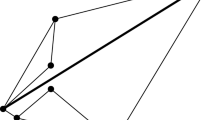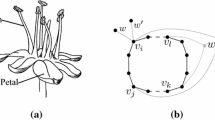Abstract
We give an output-sensitive algorithm for computing the visibility map of a set of n constant-complexity convex fat polyhedra or curved objects in 3-space. Our algorithm runs in O((n + k) polylog n) time, where k is the combinatorial complexity of the visibility map. This is the first algorithm for computing the visibility map of fat objects that does not require a depth order on the objects and is faster than the best known algorithm for general objects. It is also the first output-sensitive algorithm for curved objects that does not require a depth order.
This research was supported by the Netherlands’ Organisation for Scientific Research (NWO) under project no. 639.023.301.
Preview
Unable to display preview. Download preview PDF.
Similar content being viewed by others
References
Agarwal, P.K., Matoušek, J.: Ray shooting and parametric search. SIAM Journal on Computing 22(4), 794–806 (1993)
Bentley, J., Ottmann, T.: Algorithms for reporting and counting geometric intersections. IEEE Transactions on Computers 28, 643–647 (1979)
de Berg, M.: Ray Shooting, Depth Orders and Hidden Surface Removal. LNCS, vol. 703. Springer, Heidelberg (1993)
de Berg, M.: Vertical ray shooting for fat objects. In: Proc. 21st Annual Symposium on Computational Geometry, pp. 288–295 (2005)
de Berg, M.: Improved bounds for the union complexity of fat objects. In: Ramanujam, R., Sen, S. (eds.) FSTTCS 2005. LNCS, vol. 3821, pp. 116–127. Springer, Heidelberg (2005)
de Berg, M., Gray, C.: Vertical ray shooting and computing depth orders for fat objects. In: Proc. 17th Annual Symposium on Discrete Algorithms, pp. 494–503 (2006)
de Berg, M., Overmars, M.H.: Hidden-surface removal for c-oriented polyhedra. Comput. Geom. Theory Appl. 1, 247–268 (1992)
de Berg, M., Streppel, M.: Approximate range searching using binary space partitions. In: Proc. 24th Conference on Foundations of Software Technology and Theoretical Computer Science, pp. 110–121 (2004)
de Berg, M., van der Stappen, A.F., Vleugels, J., Katz, M.J.: Realistic input models for geometric algorithms. Algorithmica 34(1), 81–97 (2002)
Bern, M.: Hidden surface removal for rectangles. J. Comp. Syst. Sciences 40, 49–69 (1990)
Duncan, C.: Balanced Aspect Ratio Trees. PhD thesis, Johns Hopkins University (1999)
Duncan, C., Goodrich, M., Kobourov, S.: Balanced aspect ratio trees: Combining the advantages of k-d trees and octtrees. In: Proc. 10th Annual ACM-SIAM Sympos. on Discrete Algorithms, pp. 300–309 (1999)
Goodrich, M.T., Atallah, M.J., Overmars, M.H.: An input-size/output-size trade-off in the time-complexity of rectilinear hidden surface removal. In: Paterson, M.S. (ed.) Automata, Languages and Programming. LNCS, vol. 443, pp. 689–702. Springer, Heidelberg (1990)
Güting, R.H., Ottmann, T.: New algorithms for special cases of the hidden line elimination problem. Comp. Vision, Graphics and Image Processing 40, 188–204 (1987)
Katz, M.J., Overmars, M., Sharir, M.: Efficient hidden surface removal for objects with small union size. Computational Geometry: Theory and Applications 2, 223–234 (1992)
Kirkpatrick, D.: Optimal search in planar subdivisions. SIAM J. Comput. 12, 28–35 (1983)
McKenna, M.: Worst-Case Optimal Hidden Surface Removal. ACM Trans. Graphics 6, 19–28 (1987)
Pach, J., Tardos, G.: On the boundary complexity of the union of fat triangles. SIAM J. Comput. 31, 1745–1760 (2002)
Preparata, F.P., Vitter, J.S., Yvinec, M.: Computation of the axial view of a set of isothetic parallellipipes. ACM Trans. Graphics 9, 278–300 (1990)
Reif, J., Sen, S.: An efficient out-sensitive hidden surface removal algorithm and its parallelization. In: Proc. 4th Annual Symposium on Computational Geometry, pp. 193–200 (1988)
Sharir, M., Overmars, M.H.: A simple method for output-sensitive hidden surface removal. ACM Trans. Graphics 11, 1–11 (1992)
Author information
Authors and Affiliations
Editor information
Rights and permissions
Copyright information
© 2007 Springer-Verlag Berlin Heidelberg
About this paper
Cite this paper
de Berg, M., Gray, C. (2007). Computing the Visibility Map of Fat Objects. In: Dehne, F., Sack, JR., Zeh, N. (eds) Algorithms and Data Structures. WADS 2007. Lecture Notes in Computer Science, vol 4619. Springer, Berlin, Heidelberg. https://doi.org/10.1007/978-3-540-73951-7_23
Download citation
DOI: https://doi.org/10.1007/978-3-540-73951-7_23
Publisher Name: Springer, Berlin, Heidelberg
Print ISBN: 978-3-540-73948-7
Online ISBN: 978-3-540-73951-7
eBook Packages: Computer ScienceComputer Science (R0)




